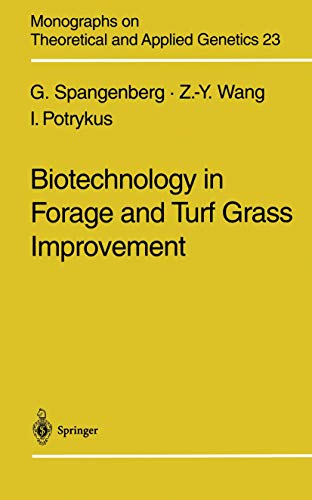Articoli correlati a Biotechnology in Forage and Turf Grass Improvement:...

Le informazioni nella sezione "Riassunto" possono far riferimento a edizioni diverse di questo titolo.
Le informazioni nella sezione "Su questo libro" possono far riferimento a edizioni diverse di questo titolo.
- EditoreSpringer
- Data di pubblicazione1998
- ISBN 10 3642720536
- ISBN 13 9783642720536
- RilegaturaCopertina flessibile
- Numero di pagine212
Compra nuovo
Scopri di più su questo articolo
Spese di spedizione:
GRATIS
In U.S.A.
I migliori risultati di ricerca su AbeBooks
Biotechnology in Forage and Turf Grass Improvement (Monographs on Theoretical and Applied Genetics) by Spangenberg, German, Wang, Zeng-Yu, Potrykus, Ingo [Paperback ]
Descrizione libro Soft Cover. Condizione: new. Codice articolo 9783642720536
Biotechnology in Forage and Turf Grass Improvement (Monographs on Theoretical and Applied Genetics, 23)
Descrizione libro Condizione: New. Codice articolo ABLIING23Mar3113020234851
Biotechnology in Forage and Turf Grass Improvement
Descrizione libro Taschenbuch. Condizione: Neu. This item is printed on demand - it takes 3-4 days longer - Neuware -Worldwide, acreage under grassland is estimated to be twice that of cropland. Two closely related genera, Festuca L. (fescues) and Lolium L. (ryegrasses) are of significant value in temperate grasslands. These genera (tribe Poeae, subfamily Pooideae) contain well-adapted, very productive grasses widely distributed in temperate and cool climates in Europe, North and South America, North, East and South Africa, Asia, Australia and New Zealand, where they are used for agricultural and recreational purposes (Jauhar 1993). They are important for grazing, stabilizing soil for agriculture, and enhancing the environment through multiple uses, such as forage, conservation and turf (Barnes 1990). Therefore, in the family Poaceae, the Festuca-Lolium group of grasses is among the most extensively studied by agronomists, plant breeders, animal scientists, taxonomists and cytogeneticists. The potential of biotechno logical approaches has been recognized for the development of improved fescue and rye grass cultivars (Barnes 1990; Kau11990; Jauhar 1993). 1. 1 Agronomic Importance of the Festuca-Lolium Complex The Festuca-Lolium complex involves some well-adapted, highly productive persistent species which are widely used for soil stabilization, for agricultural purposes and as amenity grasses. For temperate grasslands, tall fescue, meadow fescue, Italian ryegrass and perennial ryegrass are particularly impor tant species which show complementary desirable traits, such as palatability and fast initial growth of the ryegrasses, and winter hardiness, persistency combined with continued high production after the second harvest year of the fescues. 212 pp. Englisch. Codice articolo 9783642720536
Biotechnology in Forage and Turf Grass Improvement
Print on DemandDescrizione libro Condizione: New. PRINT ON DEMAND Book; New; Fast Shipping from the UK. No. book. Codice articolo ria9783642720536_lsuk
Biotechnology in Forage and Turf Grass Improvement
Descrizione libro Condizione: New. Dieser Artikel ist ein Print on Demand Artikel und wird nach Ihrer Bestellung fuer Sie gedruckt. * The first thorough description of the techniques and applications of biotechnology used to improve agronomically important temperate grasses* Beautifully illustrated1 Introduction.- 1.1 Agronomic Importance of the Festuca-Lolium Complex.- 1.1.1 M. Codice articolo 5068949
Biotechnology in Forage and Turf Grass Improvement
Descrizione libro Taschenbuch. Condizione: Neu. Druck auf Anfrage Neuware - Printed after ordering - Worldwide, acreage under grassland is estimated to be twice that of cropland. Two closely related genera, Festuca L. (fescues) and Lolium L. (ryegrasses) are of significant value in temperate grasslands. These genera (tribe Poeae, subfamily Pooideae) contain well-adapted, very productive grasses widely distributed in temperate and cool climates in Europe, North and South America, North, East and South Africa, Asia, Australia and New Zealand, where they are used for agricultural and recreational purposes (Jauhar 1993). They are important for grazing, stabilizing soil for agriculture, and enhancing the environment through multiple uses, such as forage, conservation and turf (Barnes 1990). Therefore, in the family Poaceae, the Festuca-Lolium group of grasses is among the most extensively studied by agronomists, plant breeders, animal scientists, taxonomists and cytogeneticists. The potential of biotechno logical approaches has been recognized for the development of improved fescue and rye grass cultivars (Barnes 1990; Kau11990; Jauhar 1993). 1. 1 Agronomic Importance of the Festuca-Lolium Complex The Festuca-Lolium complex involves some well-adapted, highly productive persistent species which are widely used for soil stabilization, for agricultural purposes and as amenity grasses. For temperate grasslands, tall fescue, meadow fescue, Italian ryegrass and perennial ryegrass are particularly impor tant species which show complementary desirable traits, such as palatability and fast initial growth of the ryegrasses, and winter hardiness, persistency combined with continued high production after the second harvest year of the fescues. Codice articolo 9783642720536
Biotechnology in Forage and Turf Grass Improvement
Descrizione libro Paperback. Condizione: Brand New. reprint edition. 209 pages. 9.25x6.10x0.50 inches. In Stock. Codice articolo x-3642720536

